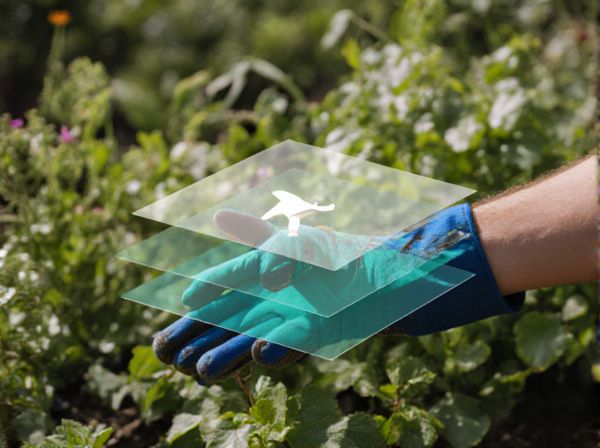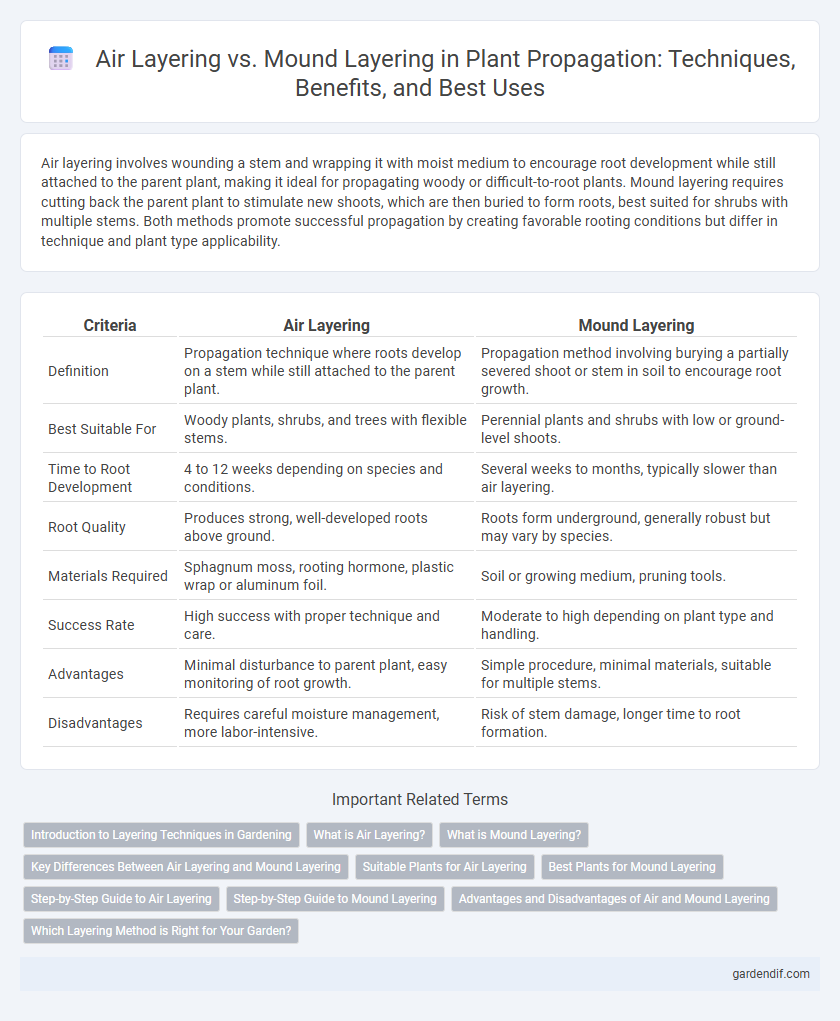
Air Layering vs Mound Layering Illustration
Air layering involves wounding a stem and wrapping it with moist medium to encourage root development while still attached to the parent plant, making it ideal for propagating woody or difficult-to-root plants. Mound layering requires cutting back the parent plant to stimulate new shoots, which are then buried to form roots, best suited for shrubs with multiple stems. Both methods promote successful propagation by creating favorable rooting conditions but differ in technique and plant type applicability.
Table of Comparison
| Criteria | Air Layering | Mound Layering |
|---|---|---|
| Definition | Propagation technique where roots develop on a stem while still attached to the parent plant. | Propagation method involving burying a partially severed shoot or stem in soil to encourage root growth. |
| Best Suitable For | Woody plants, shrubs, and trees with flexible stems. | Perennial plants and shrubs with low or ground-level shoots. |
| Time to Root Development | 4 to 12 weeks depending on species and conditions. | Several weeks to months, typically slower than air layering. |
| Root Quality | Produces strong, well-developed roots above ground. | Roots form underground, generally robust but may vary by species. |
| Materials Required | Sphagnum moss, rooting hormone, plastic wrap or aluminum foil. | Soil or growing medium, pruning tools. |
| Success Rate | High success with proper technique and care. | Moderate to high depending on plant type and handling. |
| Advantages | Minimal disturbance to parent plant, easy monitoring of root growth. | Simple procedure, minimal materials, suitable for multiple stems. |
| Disadvantages | Requires careful moisture management, more labor-intensive. | Risk of stem damage, longer time to root formation. |
Introduction to Layering Techniques in Gardening
Air layering involves inducing roots on a stem while it is still attached to the parent plant, enhancing propagation success for woody plants with less soil disturbance. Mound layering, by partially burying shoots in soil, encourages root formation at the base, making it effective for shrubs and fruit trees with multiple stems. Both techniques improve plant multiplication by leveraging natural root development processes, tailored to different plant types and growing conditions.
What is Air Layering?
Air layering is a vegetative propagation technique that involves inducing roots on a stem while it is still attached to the parent plant by wounding the stem and wrapping it with moist sphagnum moss and a protective covering until roots develop. This method is commonly used for woody plants and fruit trees like magnolia, fig, and citrus to produce clones with established root systems before separation. Air layering allows for faster propagation compared to mound layering, as it encourages root growth on a single branch without the need to mound soil around the base of the plant.
What is Mound Layering?
Mound layering is a vegetative propagation technique where a plant is pruned close to the ground, and soil is mounded over the emerging shoots to stimulate root development while still attached to the parent plant. This method is commonly used for woody shrubs and fruit trees, promoting rapid root formation in shoots covered by the mound. Mound layering is especially effective for species like currants, gooseberries, and rhododendrons, enabling efficient multiplication without requiring specialized equipment.
Key Differences Between Air Layering and Mound Layering
Air layering involves wounding a stem and wrapping it with moist medium to encourage root development on the parent plant, while mound layering requires cutting back the main plant and covering new shoots with soil to stimulate root growth from the base. Air layering is typically used for woody plants with thick stems, producing quicker root formation, whereas mound layering suits plants with flexible stems and promotes multiple rooted shoots over time. The success rate of air layering hinges on maintaining moisture in the wrapped area, while mound layering depends on the plant's capacity to regenerate roots from buried shoots.
Suitable Plants for Air Layering
Air layering is highly suitable for woody plants with flexible stems, such as magnolia, fig, and rubber plants, where new roots form along the stem while still attached to the parent plant. Unlike mound layering, which is ideal for shrubs like black currant or gooseberry, air layering excels with plants that have thick, mature branches that can be girdled and wrapped for root development. This method proves particularly effective for tropical and subtropical species, ensuring rapid propagation without the need for soil disturbance.
Best Plants for Mound Layering
Mound layering is especially effective for fruit trees such as apple, pear, and plum, as well as shrubs like forsythia and currants that respond well to this technique. This method promotes strong root development by encouraging multiple shoots to grow from the base, making it ideal for plants with vigorous basal growth. Compared to air layering, mound layering is better suited for species that naturally produce suckers or shoots close to the ground.
Step-by-Step Guide to Air Layering
Air layering involves making a small wound on a healthy branch, applying rooting hormone to the exposed area, and wrapping it with moist sphagnum moss covered by plastic to retain moisture. The wrapped section is tied securely to promote root development while attached to the parent plant. After roots form, the new plant is cut from the parent and planted independently, ensuring successful propagation.
Step-by-Step Guide to Mound Layering
Mound layering involves cutting back a plant to encourage multiple shoots, then covering these shoots with soil to promote root development while still attached to the parent plant. This process typically requires gradually piling soil around the new shoots over several weeks until roots form at the base. Proper moisture control and timely separation of rooted shoots ensure successful propagation with mound layering.
Advantages and Disadvantages of Air and Mound Layering
Air layering promotes root development on the parent plant, enabling faster propagation with less disturbance to the root system, and is ideal for woody plants and indoor species. However, it requires careful moisture management and can be labor-intensive due to wrapping and maintenance of the rooting medium. Mound layering facilitates mass propagation by encouraging multiple shoots to root simultaneously, is cost-effective for deciduous shrubs, but may lead to slower root development and greater soil exposure risks.
Which Layering Method is Right for Your Garden?
Air layering offers precise control over root development by inducing roots on a stem while it remains attached to the parent plant, making it ideal for propagating woody or delicate plants with a higher success rate. Mound layering involves bending low branches of a shrub and covering them with soil to encourage root formation, suited for plants like blackberries and raspberries that naturally branch close to the ground. Choosing the right layering method depends on the plant species, space availability, and desired propagation speed, with air layering favored for container gardens and mound layering for larger shrubs or hedges.
Air Layering vs Mound Layering Infographic

 gardendif.com
gardendif.com